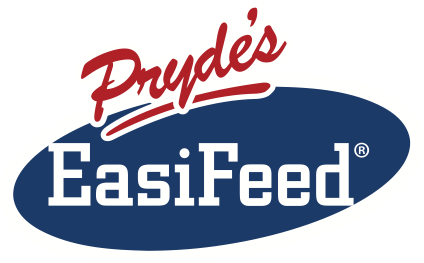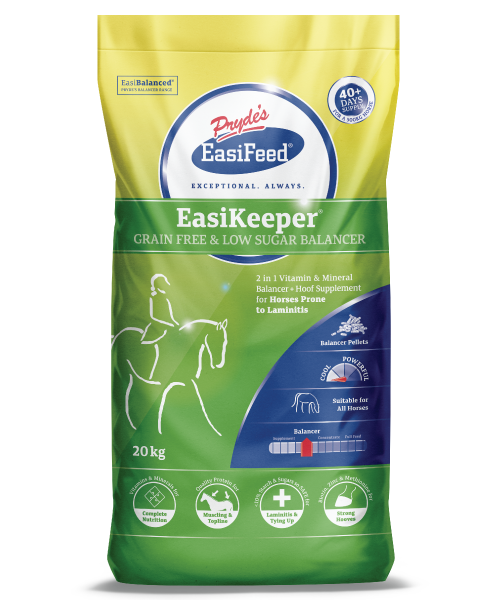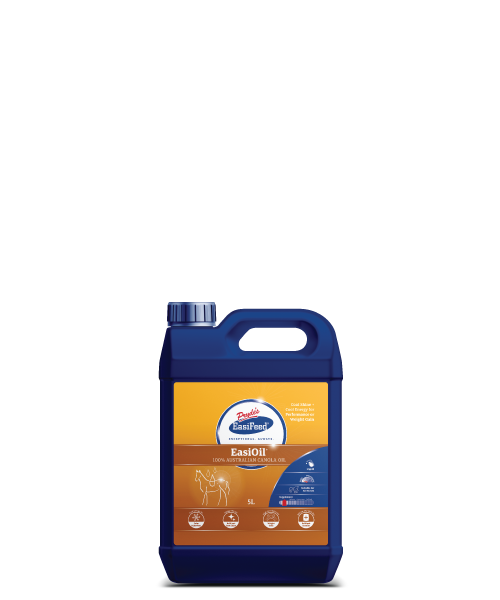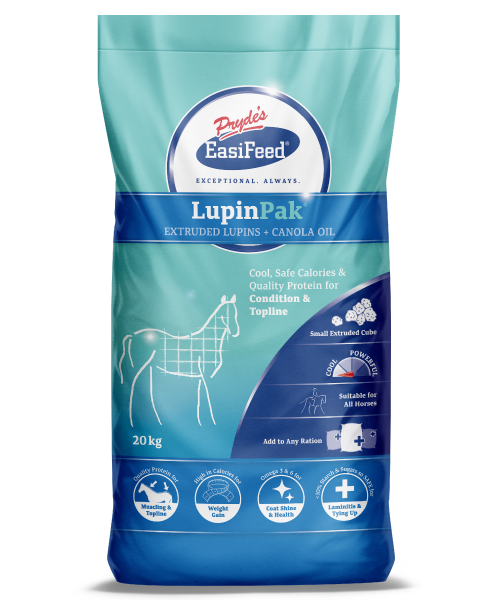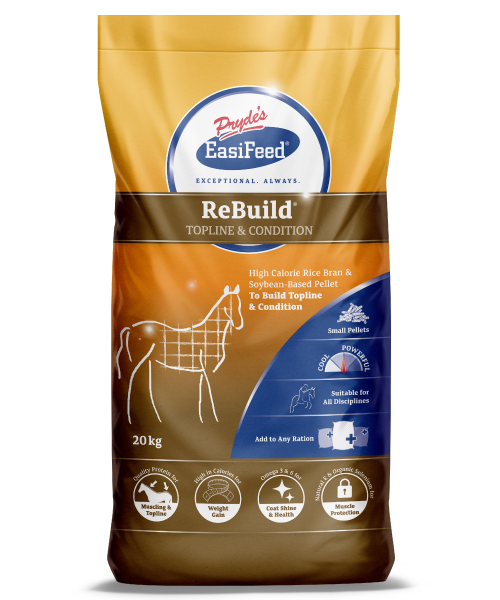Feeding a horse with a history of laminitis can be a time consuming and confusing task and one that, if not done properly, can have painful consequences for your horse.
The laminitic horse’s diet needs to be low in sugar (we could get all very technical here and call sugars non-structural carbohydrates, water soluble carbohydrates, starches, ether soluble carbohydrates or non-fibre carbohydrates, but let’s just keep it simple and say ‘sugar’). Sugars in feeds cause a horses blood insulin to rise after eating and this is what researchers now believe triggers most cases of laminitis and certainly most cases of grass or pasture laminitis.
As well as being low in sugar, the diet also needs to provide good quality protein to allow damaged hoof tissue to repair, as well as meet a horse’s requirements for vitamins and minerals.
The good news is, feeding a laminitic horse doesn’t have to be difficult. Here are some guidelines for making it a lot easier:
Base the diet on low sugar pasture or hay
All horse’s diets should be based on forage and the laminitic horse is no different. However they need low sugar forages. There are a few ways you can give your horse access to low sugar forages. These are:
Allow your horse to graze in the very early hours of the morning until about 11 am as this is when pasture sugar levels are lowest. If you are unable to control the hours of the day your horse is allowed to graze, use a grazing muzzle to reduce your horse’s intake of pasture.
Feed hays that are typically low in sugars. These include mature or stemmy tropical grass hays and mature or stemmy lucerne hay (including lucerne hay that has been weather damaged).
If you can’t access these kinds of hays, soak the hay you do have available in warm water for 30 minutes, before tipping all of the water off, rinsing and feeding.
Avoid any hays that are known to have high levels of sugar, including ryegrass hay, oaten, wheaten or barley hay.
Lucerne haylage or silage that has been produced specifically for horses is also a low sugar forage option.
Feed according to your horses need to gain, hold or lose weight
Assess the body condition (fatness) of your horse and have a clear goal in mind as to whether you want the horse to gain, hold or lose weight.
Gain Weight
If the goal is to gain weight you should:
Provide your horse with access to as much low sugar pasture or hay as it wants to eat.
Feed a low sugar complete feed at the recommended rates for your horse’s bodyweight and current activity. Complete feeds will provide your horse with the calories, protein, vitamins and minerals it needs. OR Mix your own low sugar balanced feed by using high calorie unfortified feeds like soybean hulls or sugarbeet pulp, add your own vitamins and minerals via a low dose rate vitamin and mineral supplement and add protein from soybean, lupins or faba beans.
If additional weight gain is needed add some oil to the diet. Start with ¼ of a cup per day and gradually increase the amount if required.
Maintain Weight
To maintain your horses weight you should:
Allow the horse access to up to 2.5% of its bodyweight of low sugar forage (12.5 kg for a 500 kg horse) per day.
Balance the diet with a low dose rate vitamin and mineral supplement and additional protein from soybean, lupins or faba beans if your pasture or hay quality is poor.
Monitor your horse closely. If it is not holding its bodyweight on this diet, increase the amount of low sugar forage you are feeding and reassess your horse. If it still isn’t holding its bodyweight you can add a high calorie, low sugar unfortified feeds like soybean hulls or sugarbeet pulp to the existing diet. OR Switch to using a low sugar complete feed at the recommended rate for your horse.
Lose Weight
If your horse needs to lose weight you must do it carefully, as forcing the laminitic horse into rapid weight loss can also stop them from healing their damaged hoof tissue and may cause other problems like hyperlipaemia. To gently encourage your horse to lose weight you should:
Feed up to 2% of your horses body weight (10 kg/day for a 500 kg horse) per day as low quality, low sugar forage, including mature or stemmy tropical grass hays and/or weather damaged lucerne hay.
Balance the diet with a low dose rate vitamin and mineral supplement and good quality protein from full fat soybean.
Constantly assess your horse’s body weight and adjust the diet according to the rate of weight loss. If your horse is not losing weight, reduce the amount of low sugar forage being fed to 1.5% of the horse’s current bodyweight (7.5 kg/day for a 500 kg horse). If this reduction doesn’t achieve the weight loss you want, reduce the amount of forage being fed to 1.5% of the horse’s ideal bodyweight.
To prevent boredom in these horses, make their forage hard to eat so it is more time consuming for them. One way you can do this is by placing their hay in 2 or 3 hay nets, which makes the hay hard to pull out. If you do feed hay out of hay nets you may need to dampen it down slightly to reduce dust. You should also feed their daily allocation of hay in 2 or 3 meals per day.
If the horse is able to exercise, a gentle exercise routine each day will also help them to lose weight and reduce their risk of further bouts of laminitis.
Never feed a grain or grain by-product based feed
If your horse needs extra feed in addition to the low sugar forage you are feeding you must be VERY careful when selecting a suitable feed. You should NEVER feed a feed to a laminitic horse if it has any of the following ingredients:
Oats, corn, wheat, rice or barley
Millrun, millmix, bran (rice or wheat), pollard
Any form of steam flaked, micronized or extruded grain
So read all labels and lists of ingredients carefully before buying a feed and remember.It is buyer beware. Many feeds that contain grain by-products like millrun, bran or pollard advertise themselves as being ‘grain-free’. This is grossly misleading and these feeds present as much danger to your laminitic horse as a feed that contains grain. Other feeds claim to be ‘Low GI’, but again, if they contain any of the ingredients listed above, they should be avoided for laminitic horses.
If you are considering a particular feed for your laminitic horse, call the manufacturer to see if they have had the feeds sugar and starch levels tested and ask to see the results. Ideally, feeds for laminitic horses should have a sugar and starch level of less than 12%.
Make sure the diet is balanced!
It is very important to make sure the diet you are feeding your laminitic horse is balanced. Meeting the laminitic horses requirements for protein, amino acids, vitamins and minerals will help them recover from any previous bouts of laminitis, help them to resist other disease and infection and will keep them in good overall health.
Pryde’s Products that can help.
Dr Nerida Richards
Equilize Horse Nutrition Pty Ltd
